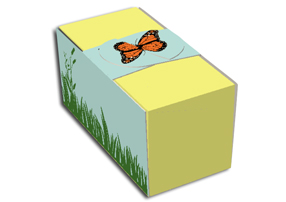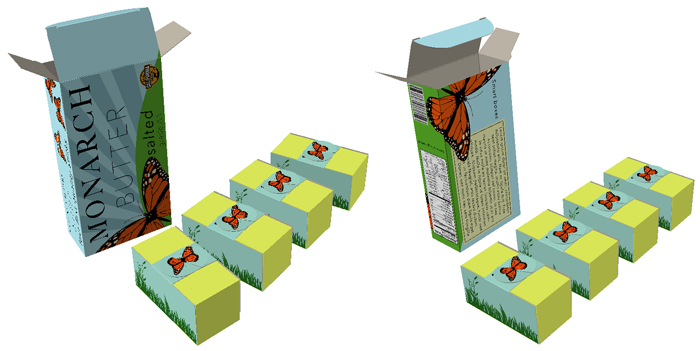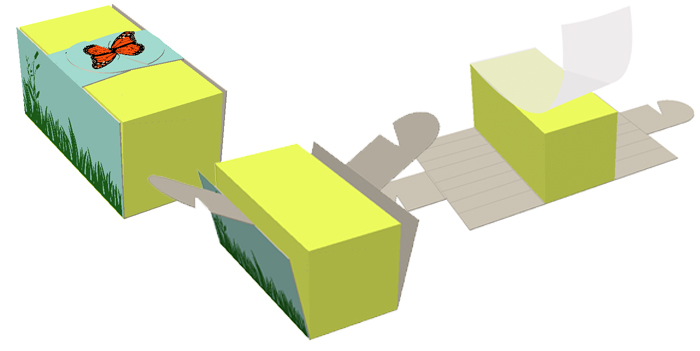Monarch Butter
Monarch Butter
| School: | San Jose State University |
| Team: | Jessica Sohn, Victor Gagneux, Julien Nguyen |

Butter is a universally beloved ingredient for its incredible culinary versatility. It has a prominent role in cooking, baking, and of course on our morning toast. Such an important ingredient deserves packaging
that makes it easy to use. The typical butter found in the supermarket is wrapped in wax paper and
contained in a paperboard folding carton, with four individually wrapped sticks to a box. A box of butter
usually has a tear away zipper on one side that frequently tears away the entire end flap, making the box
impossible to re-close. As sticks of butter are used, the empty space in the box takes up refrigerator space
that could be used for storing other things. The sticks of butter themselves are wrapped in wax paper that
requires a lot of handling to unwrap, and is very difficult to re-wrap around the butter without assistance
from plastic food wrap or a rubber band. The butter can be cut directly through the wax paper, but that
leaves the cut end exposed and prone to oxidation. It can be unwrapped and cut on a plate, which may
unnecessarily dirty a dish. Our Monarch butter packaging aims to solve these problems.
The outer box containing the sticks of butter appears friendly and eye-catching with its butterfly motif,
which also describes the mechanisms of the packaging. An easy to open, tear away zipper opens the box
right down the middle, like a cocoon, revealing the butter sticks for easy removal. The sticks are
sufficiently individually wrapped in butterfly-style packaging so that the box can immediately be recycled
without taking up space in the refrigerator. Instead of being completely wrapped in wax paper, the butter
is contained in a wax-coated paperboard sleeve that unfolds like butterfly wings. A strip of wax paper
covers the top of the butter, which is easily pulled back. Simple tabs secure the butterfly sleeve around the
butter. To use the butter, the tabs are unhooked and the sleeve “wings” are unfolded, exposing the sides
of the butter and revealing the inner surface of the paperboard which is conveniently embossed with
tablespoon measurements. The strip of wax paper is peeled back, and the butter is cut directly on its
opened sleeve. To close, the wax paper is replaced on top, the “wings” fold back up, and the tabs lock
them back in place. This entire process can be done quickly and easily without once touching the butter
with bare hands.
Unfortunately, butter packaging is inherently wasteful; any part that comes in direct contact with the
butter cannot be recycled, as it absorbs grease. But measures can be taken to lessen the impact of butter
packaging on the environment: Monarch Butter is packaged in compostable paperboard manufactured
from responsibly managed forests, printed with biodegradable inks, and coated in biodegradable soybean
wax. Interesting facts about butterflies and ways to promote butterfly conservation can be printed on the
“cocoon” box as well as each butterfly sleeve.


